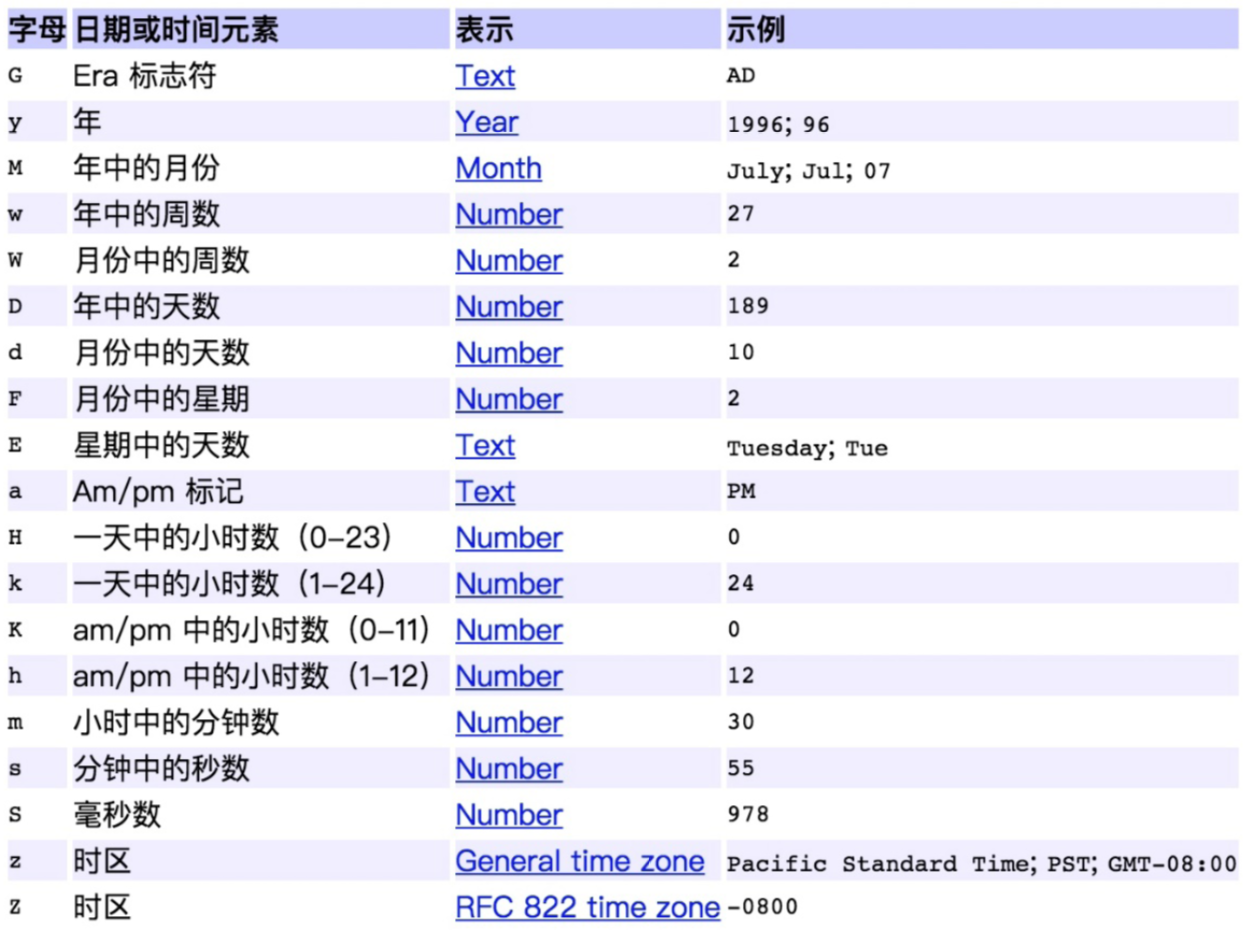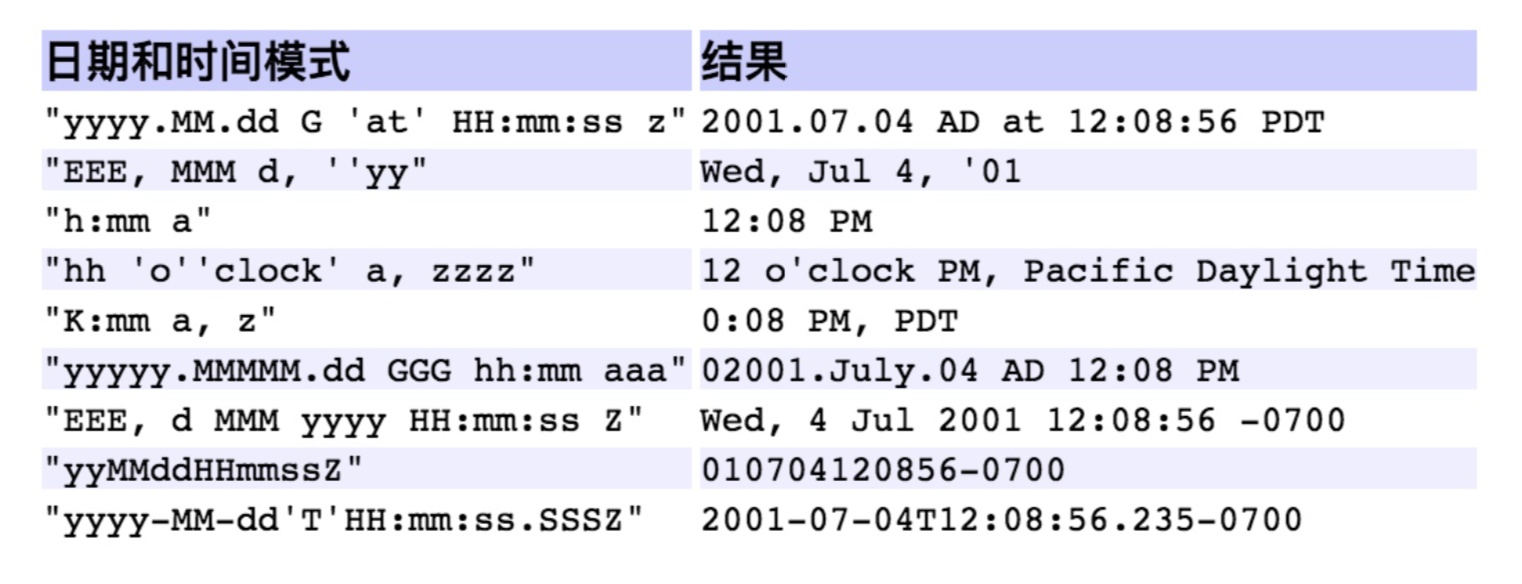本文参照 《Java技术灵魂15问》
简介
在日常开发中,我们经常会用到时间,我们有很多办法在 Java 代码中获取时 间。但是不同的方法获取到的时间的格式都不尽相同,这时候就需要一种格式化工 具,把时间显示成我们需要的格式。
最常用的方法就是使用 SimpleDateFormat 类。这是一个看上去功能比较简单 的类,但是,一旦使用不当也有可能导致很大的问题。
在 Java 开发手册中,有如下明确规定:

那么,本文就围绕 SimpleDateFormat 的用法、原理等来深入分析下如何以正 确的姿势使用它。
SimpleDateFormat 是 Java 提供的一个格式化和解析日期的工具类。它允许进 行格式化(日期 -> 文本)、解析(文本 -> 日期)和规范化。SimpleDateFormat 使 得可以选择任何用户定义的日期 - 时间格式的模式。
在 Java 中,可以使用 SimpleDateFormat 的 format 方法,将一个 Date 类型 转化成 String 类型,并且可以指定输出格式。
SimpleDateFormat 用法
1 | // Date转String |
以上代码,转换的结果是:2018-11-25 13:00:00,日期和时间格式由”日期 和时间模式”字符串指定。如果你想要转换成其他格式,只要指定不同的时间模式就 行了。
在 Java 中,可以使用 SimpleDateFormat 的 parse 方法,将一个 String 类型 转化成 Date 类型。
1 | // String转Data |
日期和时间模式表达方法
在使用 SimpleDateFormat 的时候,需要通过字母来描述时间元素,并组装成 想要的日期和时间模式。常用的时间元素和字母的对应表如下:

模式字母通常是重复的,其数量确定其精确表示。如下表是常用的输出格式的表 示方法。

输出不同时区的时间
时区是地球上的区域使用同一个时间定义。以前,人们通过观察太阳的位置(时 角)决定时间,这就使得不同经度的地方的时间有所不同(地方时)。1863 年,首次 使用时区的概念。时区通过设立一个区域的标准时间部分地解决了这个问题。
世界各个国家位于地球不同位置上,因此不同国家,特别是东西跨度大的国家日 出、日落时间必定有所偏差。这些偏差就是所谓的时差。
现今全球共分为 24 个时区。由于实用上常常 1 个国家,或 1 个省份同时跨着 2 个或更多时区,为了照顾到行政上的方便,常将 1 个国家或 1 个省份划在一起。所以 时区并不严格按南北直线来划分,而是按自然条件来划分。例如,中国幅员宽广,差 不多跨 5 个时区,但为了使用方便简单,实际上在只用东八时区的标准时即北京时间 为准。
由于不同的时区的时间是不一样的,甚至同一个国家的不同城市时间都可能不一 样,所以,在 Java 中想要获取时间的时候,要重点关注一下时区问题。
默认情况下,如果不指明,在创建日期的时候,会使用当前计算机所在的时区作为默认时区,这也是为什么我们通过只要使用new Date()就可以获取中国的当前 时间的原因。
那么,如何在 Java 代码中获取不同时区的时间呢? SimpleDateFormat 可以 实现这个功能。
1 | SimpleDateFormat sdf = new SimpleDateFormat("yyyy-MM-dd HH:mm:ss"); |
以上代码,转换的结果是:2018-11-24 21:00:00 。既中国的时间是 11 月 25 日的 13 点,而美国洛杉矶时间比中国北京时间慢了 16 个小时(这还和冬夏令时有关 系,就不详细展开了)。
如果你感兴趣,你还可以尝试打印一下美国纽约时间(America/New_York)。 纽约时间是 2018-11-25 00:00:00。纽约时间比中国北京时间早了 13 个小时。
当然,这不是显示其他时区的唯一方法,不过本文主要为了介绍 SimpleDate-Format,其他方法暂不介绍了。
SimpleDateFormat 线程安全性
由于 SimpleDateFormat 比较常用,而且在一般情况下,一个应用中的时间显 示模式都是一样的,所以很多人愿意使用如下方式定义 SimpleDateFormat:
1 | public class Main { |
⚠️ 这种定义方式,存在很大的安全隐患。
我们来看一段代码,以下代码使用线程池来执行时间输出。
1 | public class Main { |
以上代码,其实比较简单,很容易理解。就是循环一百次,每次循环的时候都在 当前时间基础上增加一个天数(这个天数随着循环次数而变化),然后把所有日期放入 一个线程安全的、带有去重功能的 Set 中,然后输出 Set 中元素个数。
正常情况下,以上代码输出结果应该是 100。但是实际执行结果是一个小于 100 的数字。
原因就是因为 SimpleDateFormat 作为一个非线程安全的类,被当做了共享变 量在多个线程中进行使用,这就出现了线程安全问题。
线程不安全原因
通过以上代码,我们发现了在并发场景中使用 SimpleDateFormat 会有线程安 全问题。其实,JDK 文档中已经明确表明了 SimpleDateFormat 不应该用在多线程 场景中:
Date formats are not synchronized. It is recommended to create separate format instances for each thread. If multiple threads access a format concurrently, it must be synchronized externally.
那么接下来分析下为什么会出现这种问题,SimpleDateFormat 底层到底是怎 么实现的?
我们跟一下 SimpleDateFormat 类中 format 方法的实现其实就能发现端倪。
1 | // Called from Format after creating a FieldDelegate |
SimpleDateFormat 中的 format 方法在执行过程中,会使用一个成员变量 calendar 来保存时间。这其实就是问题的关键。
由于我们在声明 SimpleDateFormat 的时候,使用的是 static 定义的。那么 这 个 SimpleDateFormat就是一个共享变量, 随 之,SimpleDateFormat 中 的 calendar 也就可以被多个线程访问到。
假设线程 1 刚刚执行完 calendar.setTime 把时间设置成 2018-11-11,还 没等执行完,线程 2 又执行了 calendar.setTime 把时间改成了 2018-12-12。 这时候线程 1 继续往下执行,拿到的 calendar.getTime 得到的时间就是线程 2 改 过之后的。
除了 format 方法以外,SimpleDateFormat 的 parse 方法也有同样的问题。 所以,不要把 SimpleDateFormat 作为一个共享变量使用。
如何解决线程安全问题
- 使用局部变量
不要使用static - 加同步锁
1
2
3
4
5
6
7
8
9
10
11
12
13
14
15
16for (int i = 0; i < 100; i++) { // 获取当前时间
Calendar calendar = Calendar.getInstance();
int finalI = i;
pool.execute(() -> {
// 加锁
synchronized (simpleDateFormat) {
// 时间增加
calendar.add(Calendar.DATE, finalI);
// 通过 simpleDateFormat 把时间转换成字符串
String dateString = simpleDateFormat.format(calendar.getTime()); // 把字符串放入 Set 中
dates.add(dateString);
//countDown
countDownLatch.countDown();
}
});
}
其实以上代码还有可以改进的地方,就是可以把锁的粒度再设置的小一点,可以 只对 simpleDateFormat.format 这一行加锁,这样效率更高一些。
- 使用 ThreadLocal
第三种方式,就是使用 ThreadLocal。 ThreadLocal 可以确保每个线程都可以 得到单独的一个 SimpleDateFormat 的对象,那么自然也就不存在竞争问题了。
1 | /** |
用 ThreadLocal 来实现其实是有点类似于缓存的思路,每个线程都有一个独享 的对象,避免了频繁创建对象,也避免了多线程的竞争。
当然,以上代码也有改进空间,就是,其实 SimpleDateFormat 的创建过程可 以改为延迟加载。这里就不详细介绍了。
使用 DateTimeFormatter
如果是 Java8 应用,可以使用 DateTimeFormatter 代替 SimpleDateFormat, 这是一个线程安全的格式化工具类。就像官方文档中说的,这个类 simple beautiful strong immutable thread-safe。
1 | // 解析日期 |
总结
本 文 介 绍 了 SimpleDateFormat 的 用 法,SimpleDateFormat 主 要 可 以 在 String 和 Date 之间做转换,还可以将时间转换成不同时区输出。同时提到在并发场 景中 SimpleDateFormat 是不能保证线程安全的,需要开发者自己来保证其安全性。
主要的几个手段有改为局部变量、使用 synchronized 加锁、使用 Threadlocal 为每一个线程单独创建一个等。
